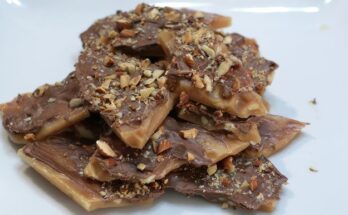Balsamic Reduction Recipe: Have you ever taken a bite of something and felt like it was missing just a little something to bring it to life? That “something” is often a drizzle of balsamic reduction. It’s sweet, tangy, thick like syrup, and packed with complex flavor that makes it a magic ingredient for both sweet and savory dishes.
Balsamic reduction—also called balsamic glaze—is simply balsamic vinegar that’s been simmered down until it thickens and intensifies in flavor. As it reduces, the natural sugars in the vinegar become more concentrated, giving it a syrupy texture and a deeper, almost caramelized flavor. It’s like the sophisticated cousin of your regular balsamic vinegar.
Why is it a kitchen must-have? It elevates everything—from grilled meats to fresh strawberries, from roasted Brussels sprouts to a scoop of vanilla ice cream. And the best part? You don’t need a fancy culinary degree to make it. All it takes is a bottle of good vinegar, a little patience, and about 20–30 minutes of your time.
In this guide, I’ll walk you through every step of making the perfect balsamic reduction. We’ll go over what ingredients you need, how to cook it without burning it, and all the ways you can use it to impress your guests—or just yourself on a Tuesday night.
Let’s dive in!
Ingredients Needed
One of the best things about balsamic reduction is its simplicity. You really only need one main ingredient—balsamic vinegar. That’s it! But if you want to jazz it up or tailor it to a particular dish, there are a few optional add-ins you can consider.
Basic Ingredient:
- 1 cup balsamic vinegar – Choose a decent quality one. You don’t need a $50 bottle, but avoid the bargain-basement stuff. Look for vinegar from Modena or with minimal additives.
Optional Add-Ins:
- 2 tbsp honey or brown sugar – To enhance sweetness (especially useful if your vinegar is on the sharp side).
- 1 garlic clove – For a bit of savory depth.
- Fresh herbs – Think rosemary, thyme, or basil for an herbal note.
- Zest of orange or lemon – Adds brightness and complexity.
- Crushed peppercorns or a chili flake pinch – For a bit of a kick.
The beauty is that you can customize the flavor based on what you’re pairing the reduction with. For dessert? Try honey and orange zest. For grilled meats? Maybe garlic and thyme.
And the ratios are forgiving. If you want to experiment with flavors, you can start small, taste frequently during the cooking process, and adjust as you go.
Tools and Equipment
Good news: you don’t need any fancy gadgets or high-end tools to make balsamic reduction at home. Just a few simple kitchen essentials will get the job done smoothly.
Must-Have Tools:
- Small to medium-sized saucepan – Nonstick or stainless steel is ideal. Choose one with a heavy bottom to avoid burning.
- Wooden spoon or silicone spatula – You’ll use this to stir occasionally and check the consistency.
- Measuring cup – To accurately measure your vinegar before pouring it in.
Optional but Useful Tools:
- Fine mesh strainer – If you’re using herbs or garlic, this helps strain them out at the end.
- Glass jar or squeeze bottle – For storing the reduction once it’s cooled.
- Kitchen thermometer – If you want to be super precise (ideal reduction happens around 225°F/107°C).
That’s it—simple, straightforward, and accessible. You don’t need to be a chef or buy any specialized equipment to master this recipe.
Step-by-Step Balsamic Reduction Recipe
Here’s where the magic happens. Follow these steps and you’ll end up with a luscious, sweet, and tangy balsamic glaze that can rival any store-bought version.
Step 1: Choose the Right Balsamic Vinegar
Not all balsamic vinegars are created equal. The first rule of thumb? Don’t use your cheapest bottle, but don’t waste your most expensive aged balsamic either. A mid-range bottle—something around $10 to $15 for 500 ml—is perfect for reductions.
Check the label. Look for:
- “Product of Modena” or “Aceto Balsamico di Modena”
- Few ingredients (mainly grape must and vinegar, not caramel coloring or thickeners)
You want a vinegar that starts off with decent body and natural sweetness. That’ll translate into a richer, more flavorful reduction.
Step 2: Measure and Pour into Saucepan
Pour 1 cup of balsamic vinegar into your saucepan. If you’re adding any optional ingredients like garlic, herbs, or sugar, now’s the time to do it.
Place the pan over medium heat—not high, not low. The goal is to bring the vinegar to a gentle simmer. Too much heat and you risk burning it, which will make it bitter.
Once the vinegar starts to bubble slightly at the edges, you’re ready for the next step.
Step 3: Simmer and Stir Gently
Keep it at a steady simmer—not a rolling boil. Stir occasionally, especially if you’ve added sweeteners like honey or sugar, which can stick to the bottom and burn.
The aroma will become more intense as the vinegar reduces. You’ll smell that characteristic sweet-tangy scent that makes your mouth water. If you’re worried about overpowering your kitchen, open a window or turn on a vent.
Let it reduce slowly. There’s no rushing perfection here.
Step 4: Reduce to Desired Thickness
As the balsamic vinegar continues to simmer, it will slowly thicken. This part usually takes 15 to 25 minutes, depending on how much vinegar you started with and the level of heat.
Here’s how to tell when it’s ready:
- The liquid has reduced by half or more.
- It coats the back of a spoon.
- When dripped onto a plate, it holds its shape for a few seconds.
Don’t overdo it! The reduction will continue to thicken as it cools. If you reduce it too far, you might end up with a sticky, unusable paste—or worse, a bitter, burned mess.
Pro tip: For a drizzle consistency, reduce until it’s about one-third of the original volume. For a thicker glaze, go for one-fourth. But always err on the side of under-reducing—it’s easy to simmer more, but impossible to undo.
Step 5: Cool and Store Properly
Once the reduction is done, remove it from the heat immediately. If you added herbs, garlic, or zest, strain them out using a fine mesh sieve. Allow it to cool slightly in the pan—just until it’s not bubbling anymore.
Then, pour the glaze into a glass jar or squeeze bottle using a funnel if needed. Avoid plastic containers while it’s hot. Let it come to room temperature before sealing the lid.
For storage:
- Keep it in the fridge in a sealed container.
- It will last for up to 1 month, often longer.
- It may thicken over time—just warm slightly to loosen it.
Now you have a rich, tangy, sweet glaze ready to transform even your simplest dishes.
Tips for the Perfect Reduction
Even though making balsamic reduction is easy, there are some pitfalls to avoid. Here are tips to ensure your glaze turns out perfect every time.
Don’t Rush It
Patience is key. If you crank up the heat to speed up the process, you’ll likely burn the vinegar. That’s not only a waste of ingredients but will leave your kitchen smelling like scorched acid.
Use Quality Vinegar
You don’t need the most expensive vinegar, but quality matters. Low-quality balsamic often contains additives like caramel color or thickeners that can ruin the flavor and texture when reduced.
Watch Closely Near the End
The final 5 minutes are the most critical. This is when the reduction goes from liquid to syrupy. It’s also when it’s most likely to over-reduce or burn. Stir frequently and stay close.
Flavor Gently
Don’t overload the vinegar with too many flavorings. Choose one or two—like honey and rosemary—or keep it plain. Simplicity often yields the best result.
Test with a Spoon
To check if it’s ready, dip a spoon into the mixture and run your finger down the back. If the line holds, it’s perfect.
By keeping these tips in mind, you’ll get consistent results and avoid ending up with bitter or overly thick balsamic sludge.
Flavor Variations You Can Try
Once you’ve mastered the basic balsamic reduction, the fun really begins. You can customize it to fit your tastes or the dish you’re planning. Here are some of the best variations to experiment with:
Sweet Versions
- Honey or Maple Syrup: Add 1–2 tablespoons for a dessert-friendly glaze.
- Brown Sugar: Enhances depth and creates a molasses-like note.
- Vanilla Extract: A splash adds a lovely twist—perfect on berries or ice cream.
Savory Additions
- Garlic: One crushed clove, simmered and then strained out, adds depth.
- Shallots: A bit of chopped shallot gives it a mellow, savory touch.
- Worcestershire Sauce: Just a dash for meat glazes or marinades.
Fruity Infusions
- Orange or Lemon Zest: Brightens the flavor and complements veggies or poultry.
- Cranberries: Simmer whole with the vinegar and strain at the end for a holiday-ready glaze.
- Apple Juice: A splash adds sweetness and pairs well with pork.
Herbal and Spicy
- Fresh Thyme or Rosemary: Simmer with the vinegar, then strain.
- Cracked Pepper or Chili Flakes: Adds heat—great for savory dishes.
Flavor variations allow you to personalize the reduction for any occasion—whether it’s a light summer salad or a rich winter roast.
Ways to Use Balsamic Reduction
This sticky-sweet glaze is incredibly versatile. Here are some of the best ways to use balsamic reduction in your everyday meals.
On Meats and Grilled Dishes
A balsamic glaze works wonders on grilled or roasted meats. It adds a glossy finish, boosts flavor, and balances rich or smoky flavors.
- Steak: Drizzle just before serving.
- Chicken thighs or breasts: Glaze in the last 5 minutes of roasting.
- Pork chops: Especially with apple or pear sides.
- Grilled sausages or kebabs: Adds a touch of elegance and zing.
You can also use it as a marinade base with olive oil, garlic, and herbs.
Over Vegetables and Salads
Want to make your veggies less boring? Just add balsamic reduction. It turns even the simplest side into a dish with gourmet flair.
- Roasted Brussels sprouts: A match made in heaven.
- Grilled asparagus or zucchini: Elevates flavor with a smoky touch.
- Caprese salad: Drizzle over tomato, mozzarella, and basil.
- Simple green salads: Use instead of or in addition to vinaigrette.
It also works great on grain bowls, adding a pop of flavor to quinoa or couscous mixes.
With Fruits and Desserts
You might not expect it, but balsamic reduction shines just as brightly in sweet dishes as it does in savory. The thick, tangy syrup pairs surprisingly well with a wide range of fruits and desserts, offering a sophisticated twist.
- Strawberries & Cream: Drizzle over fresh strawberries with whipped cream or mascarpone.
- Vanilla Ice Cream: A spoonful of balsamic glaze adds a gourmet touch.
- Grilled Peaches or Pineapple: Pairs beautifully with warm, caramelized fruit.
- Chocolate Cake or Brownies: Adds depth and tang to rich chocolate flavors.
- Cheesecake: A thin line of reduction brings contrast and elegance.
For fruit pairings, the key is moderation. Just a small amount—about a teaspoon per serving—is enough to transform the flavor profile of the entire dish.
How to Store and Reuse
You’ve made your delicious balsamic reduction—now what? The good news is, you can store and reuse it multiple times, making it a great make-ahead addition to your pantry.
Best Storage Practices
- Use a clean, airtight container – Glass jars or squeeze bottles are ideal.
- Let it cool completely before sealing the lid.
- Refrigerate it – Keeps it fresh and safe for longer.
Shelf Life
Properly stored, your balsamic glaze can last:
- Up to 1 month in the fridge for best quality.
- Possibly up to 3 months if no sugar or additives were used.
If your reduction becomes too thick over time, simply place the container in a warm water bath or microwave it for a few seconds to loosen it up again.
Signs of Spoilage
Though rare, here’s what to look out for:
- Unusual odor
- Mold or discoloration
- Taste that’s overly bitter or metallic
When stored right, it’s safe, flavorful, and ready to use on everything from roasted meats to morning waffles.
FAQs about Balsamic Reduction Recipe
Does it Contain Sugar?
Not necessarily. If you follow the basic recipe, it’s just vinegar reduced into a syrup. But you can add sugar or honey if you prefer a sweeter glaze. Commercial versions often contain added sugars.
Can it be Made in Advance?
Absolutely! It’s one of those rare condiments that gets better after resting a bit. The flavors continue to mellow and meld over time.
What’s the Difference Between Balsamic Glaze and Reduction?
Often used interchangeably, but:
- Reduction = homemade, no added thickeners
- Glaze = often store-bought, may contain cornstarch or additives
Can I Use Flavored Balsamic Vinegar?
Yes, flavored varieties like fig, pomegranate, or cherry make incredible reductions. Just check for added sugars before reducing.
What if I Burn It?
Unfortunately, burnt balsamic reduction can’t be salvaged. It’s best to toss it and start over—this time with a lower heat and close supervision.
Can I double or triple the recipe?
Yes! You can easily scale the recipe up. Just remember: the more you start with, the longer it will take to reduce. Use a wider pan to help it go faster.
Why did my reduction turn bitter?
This usually happens when it’s overcooked or burned. Keep the heat low and stir frequently to avoid bitterness.
Is balsamic reduction keto-friendly?
If made without sugar or honey, it’s low in carbs and suitable for keto diets. Always check the label if using store-bought balsamic vinegar.
Can I freeze balsamic reduction?
You can, but it’s not necessary. It keeps well in the fridge. If you freeze it, thaw gently and stir before use.
What dishes pair best with flavored reductions?
Fruit-infused reductions (like fig or cherry) work beautifully on desserts or pork. Herbal versions (like rosemary or thyme) are perfect on lamb or roasted vegetables.
Conclusion
There’s something almost magical about balsamic reduction. From just a single ingredient—or two, if you like to experiment—you can create a luxurious, complex condiment that adds serious wow factor to any meal.
Whether you’re elevating a steak dinner, brightening a salad, or surprising guests with a tangy dessert drizzle, balsamic reduction is a powerhouse addition to your kitchen. And now that you know how to make it from scratch, you’ll never have to settle for those overly sweet, artificial store-bought versions again.
So grab a bottle of good balsamic, set aside half an hour, and get ready to make something amazing. Once you try homemade balsamic reduction, you’ll wonder how you ever lived without it.



